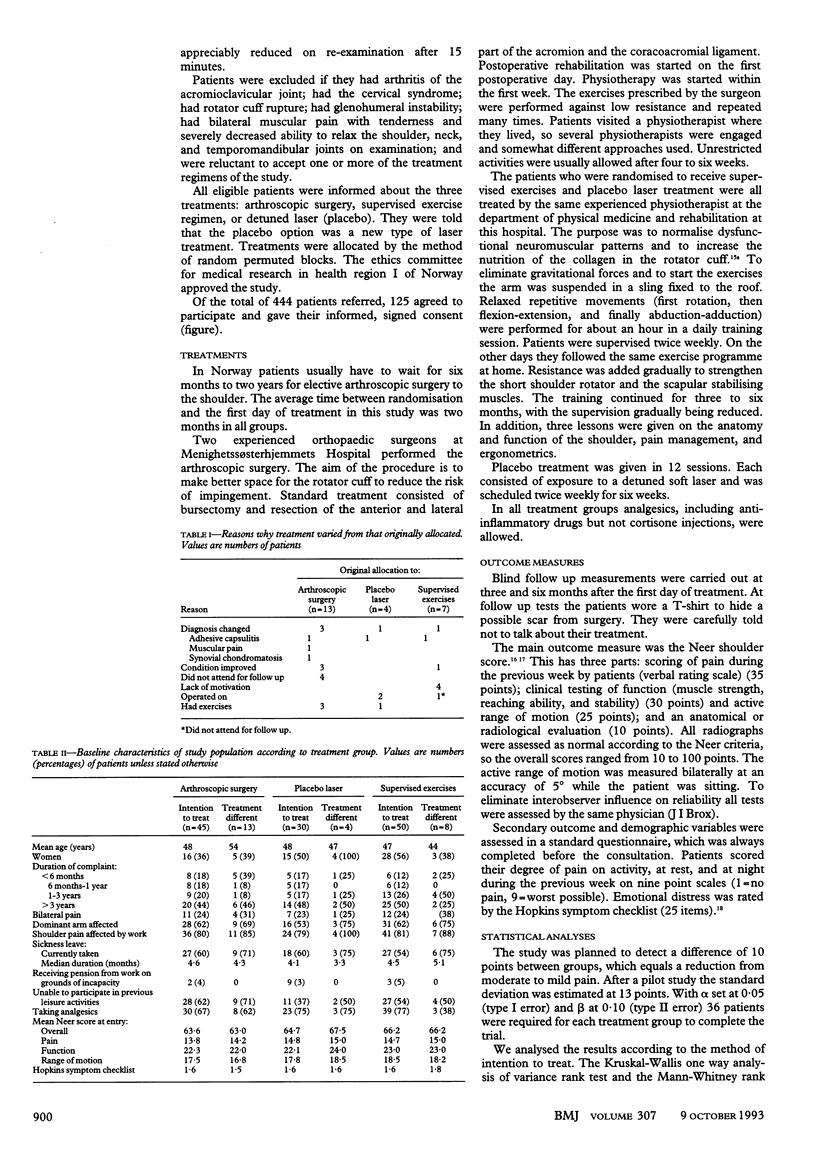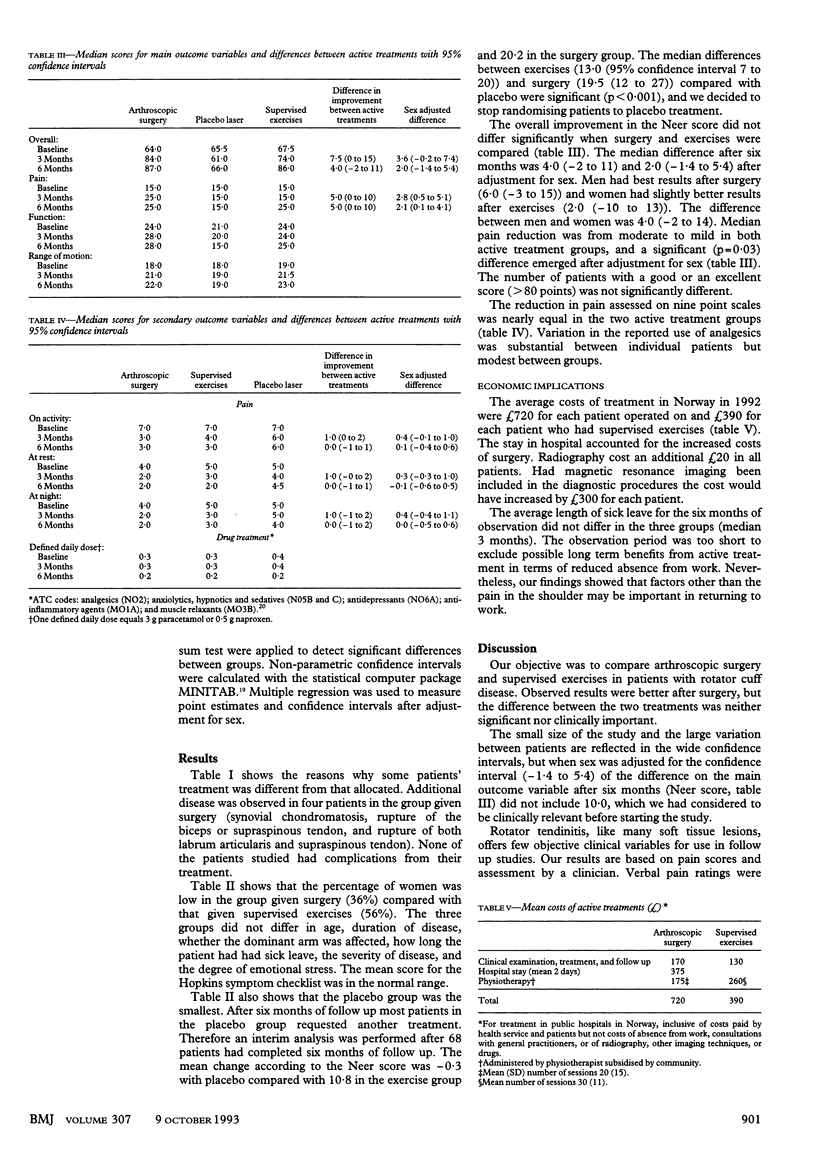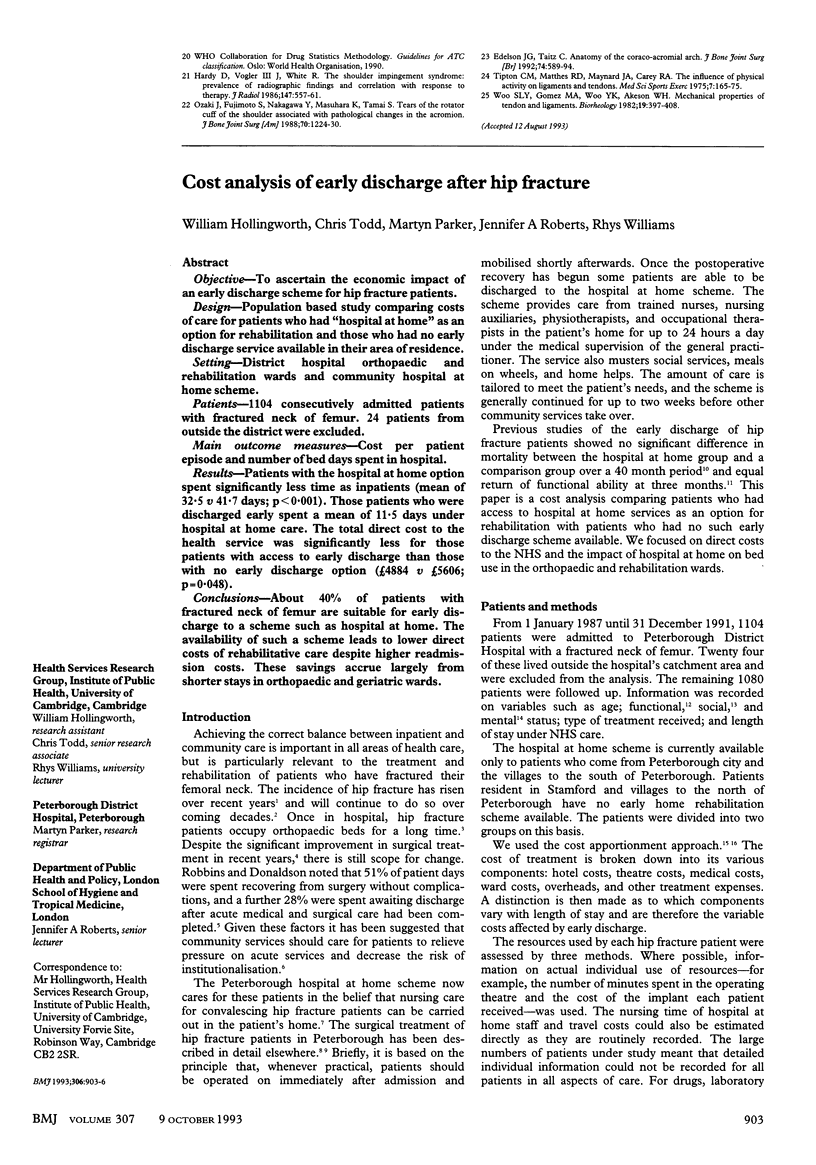Abstract
OBJECTIVE--To compare the effectiveness of arthroscopic surgery, a supervised exercise regimen, and placebo soft laser treatment in patients with rotator cuff disease (stage II impingement syndrome). DESIGN--Randomised clinical trial. SETTING--Hospital departments of orthopaedics and of physical medicine and rehabilitation. PATIENTS--125 patients aged 18-66 who had had rotator cuff disease for at least three months and whose condition was resistant to treatment. INTERVENTIONS--Arthroscopic subacromial decompression performed by two experienced surgeons; exercise regimen over three to six months supervised by one experienced physiotherapist; or 12 sessions of detuned soft laser treatment over six weeks. MAIN OUTCOME MEASURES--Change in the overall Neer shoulder score (pain during previous week and blinded evaluation of function and range of movement by one clinician) after six months. RESULTS--No differences were found between the three groups in duration of sick leave and daily intake of analgesics. After six months the difference in improvement in overall Neer score between surgery and supervised exercises was 4.0 (95% confidence interval -2 to 11) and 2.0 (-1.4 to 5.4) after adjustment for sex. The condition improved significantly compared with placebo in both groups given the active treatments. Treatment costs were higher for those given surgery (720 pounds v 390 pounds). CONCLUSIONS--Surgery or a supervised exercise regimen significantly, and equally, improved rotator cuff disease compared with placebo.
Full text
PDF




Selected References
These references are in PubMed. This may not be the complete list of references from this article.
- Bergenudd H., Lindgärde F., Nilsson B., Petersson C. J. Shoulder pain in middle age. A study of prevalence and relation to occupational work load and psychosocial factors. Clin Orthop Relat Res. 1988 Jun;(231):234–238. [PubMed] [Google Scholar]
- Björkenheim J. M., Paavolainen P., Ahovuo J., Slätis P. Surgical repair of the rotator cuff and surrounding tissues. Factors influencing the results. Clin Orthop Relat Res. 1988 Nov;(236):148–153. [PubMed] [Google Scholar]
- Bye A. Belastningslidelser hos ansatte i bygg- og anleggsbransjen. Tidsskr Nor Laegeforen. 1991 Jan 30;111(3):337–340. [PubMed] [Google Scholar]
- Chard M. D., Sattelle L. M., Hazleman B. L. The long-term outcome of rotator cuff tendinitis--a review study. Br J Rheumatol. 1988 Oct;27(5):385–389. doi: 10.1093/rheumatology/27.5.385. [DOI] [PubMed] [Google Scholar]
- Derogatis L. R., Lipman R. S., Rickels K., Uhlenhuth E. H., Covi L. The Hopkins Symptom Checklist (HSCL): a self-report symptom inventory. Behav Sci. 1974 Jan;19(1):1–15. doi: 10.1002/bs.3830190102. [DOI] [PubMed] [Google Scholar]
- Edelson J. G., Taitz C. Anatomy of the coraco-acromial arch. Relation to degeneration of the acromion. J Bone Joint Surg Br. 1992 Jul;74(4):589–594. doi: 10.1302/0301-620X.74B4.1624522. [DOI] [PubMed] [Google Scholar]
- Ellman H. Arthroscopic subacromial decompression: analysis of one- to three-year results. Arthroscopy. 1987;3(3):173–181. doi: 10.1016/s0749-8063(87)80061-0. [DOI] [PubMed] [Google Scholar]
- Hardy D. C., Vogler J. B., 3rd, White R. H. The shoulder impingement syndrome: prevalence of radiographic findings and correlation with response to therapy. AJR Am J Roentgenol. 1986 Sep;147(3):557–561. doi: 10.2214/ajr.147.3.557. [DOI] [PubMed] [Google Scholar]
- Herberts P., Kadefors R., Andersson G., Petersén I. Shoulder pain in industry: an epidemiological study on welders. Acta Orthop Scand. 1981 Jun;52(3):299–306. doi: 10.3109/17453678109050107. [DOI] [PubMed] [Google Scholar]
- Järvholm U., Palmerud G., Herberts P., Högfors C., Kadefors R. Intramuscular pressure and electromyography in the supraspinatus muscle at shoulder abduction. Clin Orthop Relat Res. 1989 Aug;(245):102–109. [PubMed] [Google Scholar]
- Lehman R. C. Shoulder pain in the competitive tennis player. Clin Sports Med. 1988 Apr;7(2):309–327. [PubMed] [Google Scholar]
- Lo Y. P., Hsu Y. C., Chan K. M. Epidemiology of shoulder impingement in upper arm sports events. Br J Sports Med. 1990 Sep;24(3):173–177. doi: 10.1136/bjsm.24.3.173. [DOI] [PMC free article] [PubMed] [Google Scholar]
- Neer C. S., 2nd Anterior acromioplasty for the chronic impingement syndrome in the shoulder: a preliminary report. J Bone Joint Surg Am. 1972 Jan;54(1):41–50. [PubMed] [Google Scholar]
- Neer C. S., 2nd Displaced proximal humeral fractures. II. Treatment of three-part and four-part displacement. J Bone Joint Surg Am. 1970 Sep;52(6):1090–1103. [PubMed] [Google Scholar]
- Ozaki J., Fujimoto S., Nakagawa Y., Masuhara K., Tamai S. Tears of the rotator cuff of the shoulder associated with pathological changes in the acromion. A study in cadavera. J Bone Joint Surg Am. 1988 Sep;70(8):1224–1230. [PubMed] [Google Scholar]
- Post M., Cohen J. Impingement syndrome. A review of late stage II and early stage III lesions. Clin Orthop Relat Res. 1986 Jun;(207):126–132. [PubMed] [Google Scholar]
- Tipton C. M., Matthes R. D., Maynard J. A., Carey R. A. The influence of physical activity on ligaments and tendons. Med Sci Sports. 1975 Fall;7(3):165–175. [PubMed] [Google Scholar]
- Woo S. L., Gomez M. A., Woo Y. K., Akeson W. H. Mechanical properties of tendons and ligaments. II. The relationships of immobilization and exercise on tissue remodeling. Biorheology. 1982;19(3):397–408. doi: 10.3233/bir-1982-19302. [DOI] [PubMed] [Google Scholar]


